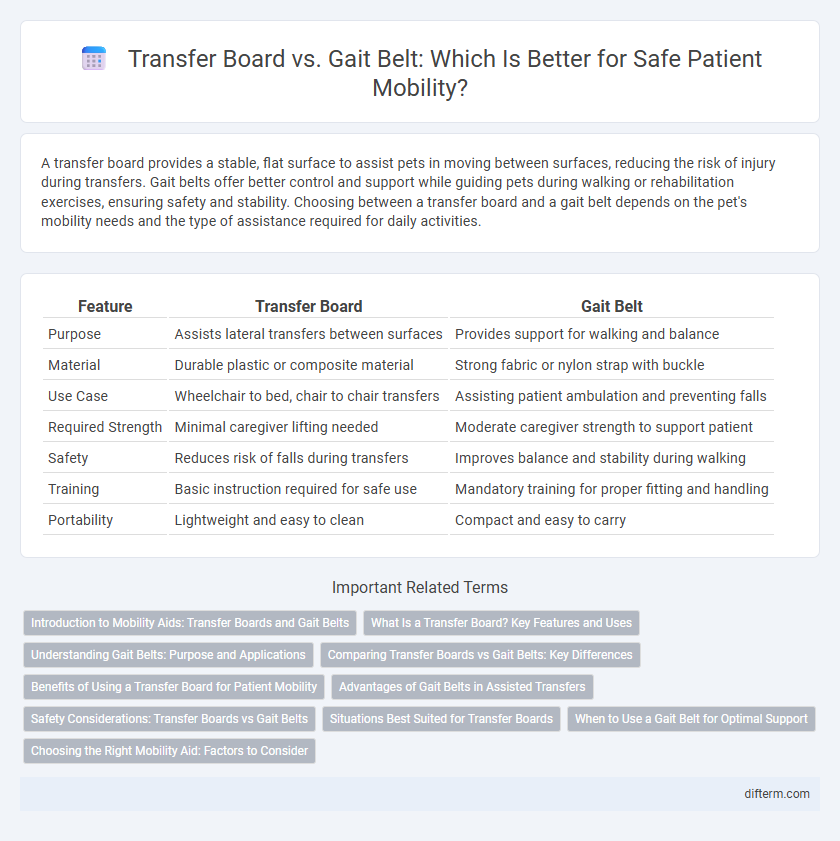A transfer board provides a stable, flat surface to assist pets in moving between surfaces, reducing the risk of injury during transfers. Gait belts offer better control and support while guiding pets during walking or rehabilitation exercises, ensuring safety and stability. Choosing between a transfer board and a gait belt depends on the pet's mobility needs and the type of assistance required for daily activities.
Table of Comparison
| Feature | Transfer Board | Gait Belt |
|---|---|---|
| Purpose | Assists lateral transfers between surfaces | Provides support for walking and balance |
| Material | Durable plastic or composite material | Strong fabric or nylon strap with buckle |
| Use Case | Wheelchair to bed, chair to chair transfers | Assisting patient ambulation and preventing falls |
| Required Strength | Minimal caregiver lifting needed | Moderate caregiver strength to support patient |
| Safety | Reduces risk of falls during transfers | Improves balance and stability during walking |
| Training | Basic instruction required for safe use | Mandatory training for proper fitting and handling |
| Portability | Lightweight and easy to clean | Compact and easy to carry |
Introduction to Mobility Aids: Transfer Boards and Gait Belts
Transfer boards facilitate safe lateral movement between surfaces by providing a smooth, stable platform that minimizes friction and reduces the risk of falls during patient transfers. Gait belts offer secure handholds around a patient's waist, enabling caregivers to provide controlled support and improve balance during ambulation or standing exercises. Both mobility aids are essential in rehabilitation and caregiving environments to enhance patient safety and promote independence.
What Is a Transfer Board? Key Features and Uses
A transfer board is a flat, rigid device designed to assist individuals with limited mobility in moving safely between surfaces such as beds, chairs, or wheelchairs. Key features include a smooth, low-friction surface that facilitates sliding, lightweight and durable materials like plastic or fiberglass, and handles or grip areas for better control during transfers. It is primarily used to reduce caregiver strain and enhance patient safety by providing stable support during repositioning and transfers.
Understanding Gait Belts: Purpose and Applications
Gait belts are designed to provide secure handholds for caregivers when assisting patients with balance or ambulation, reducing the risk of falls during transfers and walking. Unlike transfer boards, which serve as a physical platform for sliding patients between surfaces, gait belts enhance stability by allowing controlled support during movement. Proper application of gait belts improves mobility assistance and safety in healthcare settings.
Comparing Transfer Boards vs Gait Belts: Key Differences
Transfer boards facilitate safe and smooth lateral movements between surfaces by creating a stable bridge, reducing the risk of falls during transfers. Gait belts provide caregivers with secure handholds to support and stabilize patients during walking or standing, enhancing balance and preventing joint strain. Choosing between transfer boards and gait belts depends on patient mobility levels, transfer environment, and caregiver involvement for optimal safety and efficiency.
Benefits of Using a Transfer Board for Patient Mobility
A transfer board enhances patient mobility by providing a stable, low-friction surface that helps reduce the risk of falls and injury during transfers. It allows caregivers to move patients smoothly between surfaces like beds and wheelchairs, minimizing physical strain and improving safety. Utilizing a transfer board also promotes greater independence for patients with limited mobility compared to gait belts, which primarily offer support but require more manual effort.
Advantages of Gait Belts in Assisted Transfers
Gait belts provide superior control and stability during assisted transfers, reducing the risk of falls and injuries for both caregivers and patients. They offer a secure grip around the waist, enabling smoother and safer movement compared to transfer boards, which rely on sliding techniques that may cause friction and discomfort. Gait belts also facilitate better posture support and allow for easier adjustments in real-time, enhancing overall transfer efficiency and patient confidence.
Safety Considerations: Transfer Boards vs Gait Belts
Transfer boards provide a stable, low-friction surface that minimizes the risk of falls and reduces patient strain during lateral transfers, making them ideal for wheelchair-to-bed transitions. Gait belts offer caregivers a secure grip to assist with balance and mobility but require proper technique to prevent skin injury and ensure patient comfort. Safety considerations prioritize the patient's condition and the caregiver's ability, with transfer boards favored for immobile patients and gait belts best suited for those with some weight-bearing capacity.
Situations Best Suited for Transfer Boards
Transfer boards are best suited for patients with partial weight-bearing ability who need to move between surfaces of similar height, such as from a wheelchair to a car seat or bed. They offer a more stable and smooth transfer option, reducing strain on caregivers and minimizing fall risk for individuals with limited lower-body strength or balance. Unlike gait belts, transfer boards excel in situations where sliding motion is required over short distances without the need for full weight support.
When to Use a Gait Belt for Optimal Support
Use a gait belt for optimal support when assisting a patient who requires stability during ambulation or transfer but can bear weight partially or fully. It provides better grip and control, reducing the risk of falls during walking or standing activities. In contrast, a transfer board is more suitable for patients with limited lower body strength or unable to bear weight during lateral transfers.
Choosing the Right Mobility Aid: Factors to Consider
When selecting between a transfer board and a gait belt, consider the patient's level of mobility, strength, and safety needs. Transfer boards are ideal for individuals with limited lower body strength who can sit independently, facilitating smooth sliding transfers. Gait belts provide enhanced support during ambulation and transfers for patients requiring assistance with balance or stability, reducing caregiver strain and injury risk.
transfer board vs gait belt Infographic

 difterm.com
difterm.com